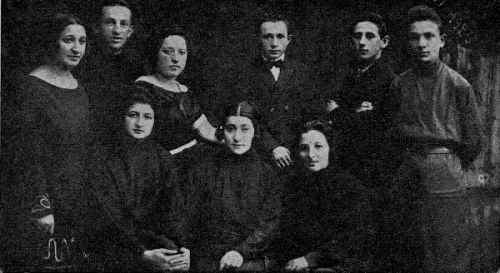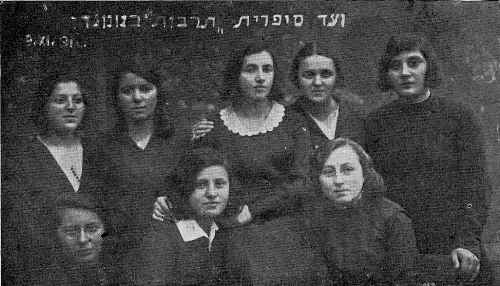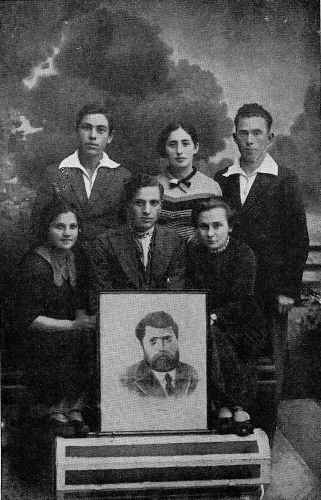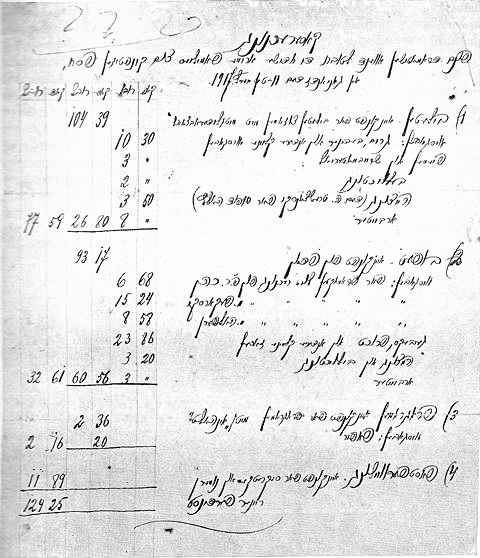[Page 115]
The Library
Yekhezkeil-Perec Tsherniak
Translated by Gloria Berkenstat Freund
I remember when I was still a child, a covered wagon harnessed to an emaciated little horse, irritated at the neck from the rubbing of his horse collar, throwing his head back and forth, would come to the beis-medrash [synagogue or house of prayer]. A Jew, an itinerant book peddler, would crawl out of the covered wagon and would unpack his wares in the beis-medrash: tefilin [phylacteries], tsitsis [garments worn by observant Jewish males with fringes hanging from their four corners], mezuzahs [small boxes containing a piece of parchment with the central Jewish prayer, Shema Yisroel - Hear, O Israel], small prayer books, Makhzors [prayer books for Rosh Hashanah and Yom Kippur], Mishnayos [first section of the Talmud], Yahrzeitn [multiple year calendars to record the anniversary of a death], Shire haMaalos [Psalm 121 “…I raise my eyes upon the mountains; whence will come my help?” - recited to protect women in childbirth from evil spirits] for women in childbirth and other things. This was all openly done. In secret, he also traded in novels of Shomer [pseudonym of Yiddish writer Nakhum Meir Shaikewitz] and others. And if there were no people interested in buying, he would rent [the books] to them to read.
Although Goniadz stood higher culturally than the poor shtetlekh [towns], there was no city library in Goniadz. Several young men - Yankl Rudski's son Dovid, Yitzhak the son of the religious judge's wife, Hershl Vigodski (Bina's son], Chaim-Meir's son Hershl-Leib, Shlomo-Josl's son Kheikl, Sheime's son Josel, Moshe the Kievianker and others - came together and founded a library.
The first library was in a separate small room in Shlomo-Josl's house, for which we paid rent. At the beginning, the library consisted of gifts and some purchased Yiddish and Russian books and of a very small number of books in the holy tongue [Hebrew]. The library also subscribed to the first Yiddish newspaper that was published at that time in Petersburg, Der Freind [The Friend]. And the entire shtetl would make use of the newspaper, until after several weeks everyone had read it.
The official stamp of the library was gezelshaftlekhe biblotek in Goniadz [communal library in Goniadz] (obszczezitelnyja biblioteka
[Page 116]
v Goniadza). The above-mentioned young men also were the founders of the young Zionist movement. Thus all of the Zionist activity was concentrated around the library premises.
The library moved from Shlomo-Josl's to a fine, new room at Matka Klap's. There the library received a new name, Beit Eked haSefarim [Book Collection] of Gonaidz. The stamp was more distinguished - in the form of a book.
This was after [Theodor] Herzl's death. In 1904, we moved the library to Reb Benyamin the Scribe's house from Matka Klap's. The library then had over 4,000 books. Yiddish took the first spot, then Russian and Hebrew. At first, during the founding, a founder was “on duty” daily at the library; to provide care for the books, give suggestions as to what to read.
In about 1910-1911 the first confrontation occurred between the leaders of the library of the Zionist youth with the representatives of the Bund who demanded that, besides their participation in the management of the library Bundist literature be brought in. A general meeting of the subscribers of the library was called and the demand was rejected. However, Leibl Mankowski, the then representative of the Bund agreed to remain on the managing committee. Thus the conflict ended.
The library developed very well until the war in 1914. When they
[Pages 117-118]
|
|
Managing Committee of the Tarbut-Library in 1925
[Ed: Tarbut was a Zionist network of Hebrew-language educational institutions founded in 1922]
First row (from the right): Fishl Yitzhaki, Sholem Neiwodowski, Fishl Furman, Chaya Gelbard, Meir Treszczanski Baylka Kliap
Second row: Gronya Kliap, Rywka Kobrinski, Chaya Bachrach. |
|
|
Managing Committee of the Tarbut-Library in 1931
First row (from the right): Yehuda Bialostocki, Faygl Bajnstajn, Pesha Garber, Liba Frydman, Ruchl Rubin
Second row: Chaya Plaskowski, Ruchl Goniandzki, Fruma Halpern) |
[Page 119]
began to bomb Goniadz, the library was moved to Moshe Bandke's shop cellar. An explosion near the cellar burned a portion of the books. We packed a number of the better books in crates and took them on our wandering way, first to Kniszyn, Yaszinowke and then to Bialystok. At the end of 1915, when the Goniadz residents returned home, they brought the books
[Page 120]
packed in the crates and founded the new library on the second floor of Baylka Pesha's house. The remaining books from Moshe Bandke's cellar served as the basis for the library in the surrounding shtetlekh [towns]. The library was the center of the Zionist organization until the destruction of Goniadz. The library was enriched with many new Yiddish and Hebrew books.
|
|
Managing Committee of the Y. Kh. Berner Library in 1934
First row (from the right): Yeshaya Burak, Shayna Rajgrodski, Dovid Lichtensztajn
Second row: Ruchl Trachimowski, Ruwin Trescszanski. Ruchl Khazan |
[Page 121]
The Dramatic Circle
Yekhezkiel Peretz Tsherniak
Translated by Gloria Berkenstat Freund
Goniadz intellectual youth had a lively interest in all kinds of cultural activities. A particular love for music and theater developed along with interest in literature, Hebrew, Yiddish and Russian. From time to time choirs would be founded that would appear on various occasions, as for example at the Zionist Shimkhas-Torah minyonim[1] and Chanukah balls with a program of Hebrew and Yiddish songs.
Yiddish performances were carried out in Goniadz at various times at every opportunity during the time of the Czarist regime. Young men and girls from every party tendency took part. About 60 years ago, at the beginning of our century [20th], an amateur dramatic group was founded under the direction of Avraham'ke's son, Moshe Kopl, Khine's son, Hershl (Wigodki), Dinke's son, Lev Chaim (Koplman), Siomke Yidkowski (the midwife's son), Chaim Hersh Lewin, Pesakh, Zorakh and Yosl Szajmes and others. The performances took place in Itshe's Anshl's granary.
Several years later, the comedy, Di Tsvei Kuni Lemelekh [The Two Kuni Lemels] by A. Goldfaden was performed in the same granary under the direction of Reznik - an assistant of the photographer Karasik. Those taking part were: Yisroel-Yosef Rudski (in the role of Reb Pinkhasl), Yekheskiel Tsherniak (in the … woman's role, “Karolina”), Ahron Rudski (in the role of the woman “Libela
[Page 122]
the seamstress”). There were no talented girls available to play the women's roles then.
The dramatic circle became a stable institution in the years of the First World War under the German occupation, when the areas inhabited by the Jewish population were allowed to create Jewish culture and art unions.
Jewish dramatic circles were founded in Bialystok and in a number of other cities and shtetlekh that attracted professional actors and helped to develop many young artistic talents.
In addition to entertaining, the performances also were intended to create the financial means for certain cultural institutions, such as the school, library, as well as for Jewish communal and philanthropic purposes.
In 1915, Di Shkhite [The Slaughter] by Yakov Gordon under the direction of Goldberg (an employee of Avraham Rudski) was performed in Yankl Rudski's brewery. The performance was very successful and created a great interest in Yiddish theater art in the shtetl. A year later the play Got, Mentsh un Tayvl [God, Man and Devil] was performed with great success. Then came the plays: Di Yesoyme [The Orphan], Kreytzer Sonata [The Kreutzer Sonata], Di Teg fun Undzer Lebn [The Days of Our Life] (by Leonid Andreyev). Later, Yakov Boyle, Der Meturef [The Lunatic] and also Der Batlen [The Idler] of Y.L. Peretz.
The members of the dramatic circle took part in the performances:
[Page 123]
|
|
| Handwritten treasurer's report |
Itka Meres (Halpern), Zelig Polak, Avraham Rudski, Chaya Rubin, Shimeon Halpern, may he rest in peace, Chana Machey, the rabbi's daughter, Itka, and others. Itka Rudski, Yehezkiel Czarniak, Goldberg. Leibl Makowski had a great part in arranging the performances and the technical preparations were carried out by Moshe Furman.
[Page 124]
The last performances were arranged under the leadership of Zeydke Altshuld and others.
Thus, the dramatic circle always contributed to the communal, cultural life of our dear Goniadz.
Translator's footnote:
- Shimkhas-Torah is the autumn holiday celebrating the completion of the yearly Torah readings and the start of the new year of reading the Torah. A minyon - minyonim is the plural form - is the 10 men necessary for prayer. Here, minyon may have been used in an ironic sense. Return
This material is made available by JewishGen, Inc.
and the Yizkor Book Project for the purpose of
fulfilling our
mission of disseminating information about the Holocaust and
destroyed Jewish communities.
This material may not be copied,
sold or bartered without JewishGen, Inc.'s permission. Rights may be
reserved by the copyright holder.
JewishGen, Inc. makes no representations regarding the accuracy of
the translation. The reader may wish to refer to the original material
for verification.
JewishGen is not responsible for inaccuracies or omissions in the original work and cannot rewrite or edit the text to correct inaccuracies and/or omissions.
Our mission is to produce a translation of the original work and we cannot verify the accuracy of statements or alter facts cited.
 Goniadz, Poland
Goniadz, Poland
 Yizkor Book Project
Yizkor Book Project
 JewishGen Home Page
JewishGen Home Page
Yizkor Book Director, Lance Ackerfeld
This web page created by Jason Hallgarten
Copyright © 1999-2025 by JewishGen, Inc.
Updated 18 May 2014 by LA






